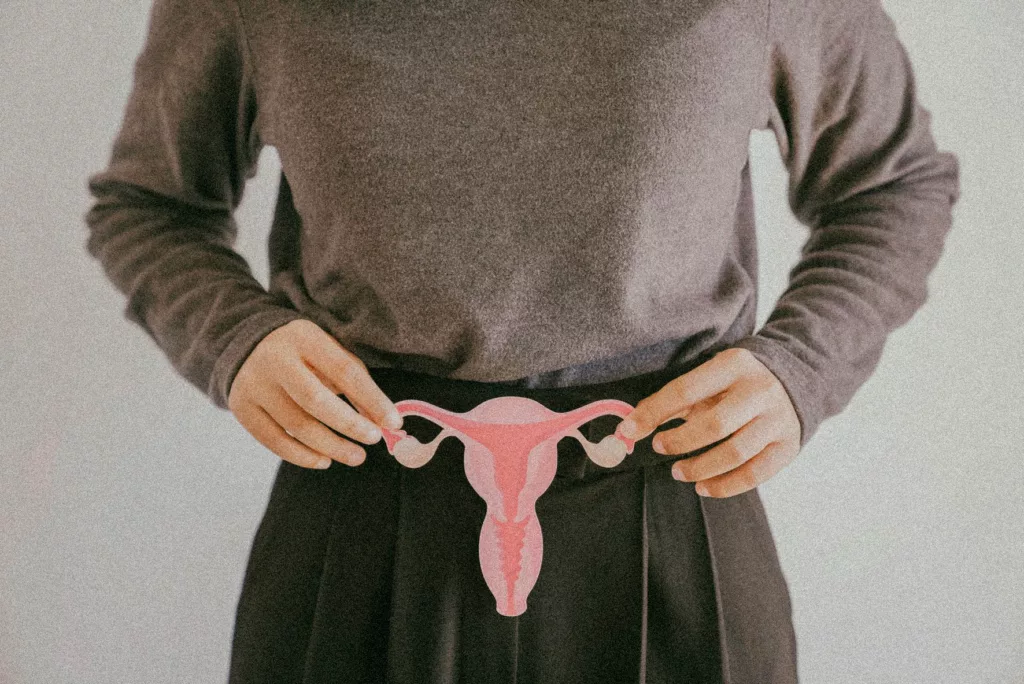Endometrial biopsy - when is it necessary and what does it reveal?
An endometrial biopsy is a diagnostic test of the endometrium. It helps detect causes of abnormal bleeding and fertility problems. Find out when it is needed, how it is performed and what it can detect.
Make an appointment for an endometrial biopsy
⬇️
Key Information
- An endometrial biopsy is a diagnostic test that evaluates the condition of the endometrium, using various methods to collect material for histopathological analysis.
- The procedure is indicated in the diagnosis of abnormal bleeding, fertility problems and in the evaluation of pathological lesions such as endometrial cancer or endometriosis.
- An endometrial biopsy can improve the chances of embryo implantation after IVF procedures, as minor damage to the mucosa stimulates regenerative processes.
What is an endometrial biopsy?
Endometrial biopsy is a minimally invasive diagnostic endometrial biopsy test used to assess the condition of the endometrium. It involves taking a section of the endometrium, or endometrium, for histopathological evaluation and detection of any pathological changes. The endometrium is the layer lining the inside of the uterus, which plays a key role in the menstrual cycle and the process of embryo implantation.
Before performing an endometrial biopsy, an ultrasound is usually recommended to assess the condition of the uterus and ensure that the patient is not pregnant. This examination helps the doctor determine exactly which areas of the endometrium should be biopsied, as well as rule out suspected ectopic pregnancy.
An endometrial biopsy can be performed using various methods, such as aspiration biopsy, hysteroscopic biopsy or curettage. Each of these methods has its own specific applications and can be tailored to the individual patient’s needs.

Indications for endometrial biopsy
Before:
There are many indications for endometrial biopsy. One of the most important is the diagnosis of abnormal bleeding, which can be a symptom of various gynecological conditions. In such cases, the biopsy allows us to thoroughly investigate the causes of these bleedings and implement appropriate treatment.
After:
There are many indications for endometrial biopsy. Here are some of them:

- Diagnosis of abnormal bleeding, which can be a symptom of various gynecological conditions.
- Enabling a thorough investigation into the causes of these bleedings.
- Implement appropriate treatment based on biopsy results.
Endometrial biopsy is an important tool in gynecological diagnosis.
Infertility diagnosis is another reason why an endometrial biopsy may be necessary. Performing this procedure can help identify lesions, such as endometrial hyperplasia, that may affect fertility. Endometriosis and endometrial cancer are also common causes of infertility that can be diagnosed with a biopsy.
An endometrial biopsy is also helpful in diagnosing other uterine lesions, such as submucous myomas, which can cause abnormal bleeding and other symptoms. Verification of the ultrasound image and histopathological evaluation of the collected material allows precise determination of the type and extent of the disease.
How does the endometrial biopsy proceed?
An endometrial biopsy is performed in a gynecologist’s office and usually requires no special preparation or anesthesia. During the procedure, the doctor inserts a thin tube into the uterine cavity through the cervical canal and sucks out a piece of endometrium, as well as material from within the mucosa of the uterine cavity. The entire procedure usually takes a few minutes and can be somewhat uncomfortable, but most patients experience only minor discomfort.
There are various methods of performing an endometrial biopsy, including aspiration biopsy, hysteroscopic biopsy and curettage. Step aspiration endometrial biopsy is one of the most commonly used methods due to its low invasiveness and effectiveness. Each of these methods has its own specific applications and can be tailored to the individual patient’s needs.
An important part of biopsy preparation is an ultrasound examination, which helps the doctor determine exactly which areas of the endometrium should be biopsied. This makes the procedure more precise and effective.
Preparation for endometrial biopsy

Before performing an endometrial biopsy, patients should undergo a gynecological ultrasound to assess the condition of the uterus and ensure that they are not pregnant and rule out suspected ectopic pregnancy. This examination is crucial to avoid possible complications and increase the effectiveness of the procedure.
Patients are also advised to be relaxed and avoid intercourse for two weeks before menstruation to facilitate the procedure and minimize the risk of infection. Endometrial biopsy usually does not require anesthesia and is performed in an outpatient office, making it relatively easy to perform and not requiring a long recovery.
What does an endometrial biopsy detect?
Endometrial biopsy is a key tool in the diagnosis of various diseases of the endometrium. It allows to confirm or exclude the presence of endometrial cancer and other cancers, including endometrial cancer, in the early stages. Early detection of these lesions is extremely important for the effectiveness of treatment.
The procedure can also reveal inflammation and infection of the endometrium, which can lead to infertility and other health problems. With a biopsy, it is also possible to diagnose menstrual cycle disorders, which is important for women struggling with abnormal bleeding.
Abnormal bleeding from the reproductive tract can be a symptom of more serious health problems, so an endometrial biopsy is often recommended in such cases. The biopsy also allows detection of abnormal growth of the endometrium, which can be the cause of abnormal bleeding and other complaints.

Possible complications after endometrial biopsy
Like any medical procedure, endometrial biopsy can be associated with some complications. The most common problem is minor bleeding or spotting, which usually lasts a few days. Patients may also experience cramping in the lower abdomen, which is a side effect of the procedure.
Less commonly, more serious complications can occur, such as perforation of the uterine wall, which requires immediate medical intervention. Infection is also a possible complication after endometrial biopsy, which may require additional antibiotic treatment. Most complications occur within the first 12 hours after the procedure, so patients should be under medical observation during this time.
Despite these potential complications, endometrial biopsy is generally a safe procedure with many diagnostic and therapeutic benefits. It is important for patients to be aware of the possible risks and consult their doctor if they have any worrisome symptoms.
Endometrial biopsy vs menstruation
An endometrial biopsy is usually performed between days 7 and 10 of the menstrual cycle, which provides the best diagnostic results. During this period, the endometrium is thickest, making it easier to collect enough material for histopathological examination.
Performing the biopsy at this particular time in the cycle also helps minimize the risk of complications and increases the accuracy of the results.
Recommendations after endometrial biopsy procedure
After endometrial biopsy, patients should avoid intercourse until the end of the menstrual cycle to minimize the risk of infection and allow the endometrium to fully heal. It is also recommended to avoid sexual intercourse for 10-14 days after the procedure.
Patients should be under a doctor’s observation for several hours after the procedure to monitor any complications. You should also refrain from using tampons and vaginal irrigation for 10-14 days to help prevent infections. In some cases, the doctor may recommend antibiotics to reduce the risk of infection.
Endometrial biopsy and infertility
An endometrial biopsy can be an important tool in the diagnosis of infertility. It can help determine the cause of pregnancy problems, such as lesions in the endometrium. Performing an endometrial biopsy during the luteal cycle can increase the chance of successful embryo implantation.
Endometrial biopsy, also known as endometrial scratching, involves damage to the endometrium, which triggers the repair process and improves its receptivity. Performing this procedure can double the likelihood of embryo implantation, which is particularly important for women undergoing IVF.
Although the mechanism by which minor damage to the endometrium increases the chances of embryo implantation is not clearly established, studies show that the effects of endometrial biopsy help improve conditions for embryo implantation.

Summary
An endometrial biopsy is a valuable diagnostic tool that can help detect a variety of endometrial conditions, from abnormal bleeding to endometrial cancer. The procedure is relatively minimally invasive and usually safe, although it may be associated with some complications, which are, however, rare.
If you have any concerns about the health of your endometrium or experience abnormal bleeding, consult your doctor. An endometrial biopsy can provide valuable information to help further your treatment and improve your quality of life.
Frequently Asked Questions
The most common complications after an endometrial biopsy include minor bleeding or spotting and cramping in the lower abdomen. Less commonly, more serious problems such as perforation of the uterine wall or infection may occur.
An endometrial biopsy is usually not painful, but may cause some discomfort. Most patients experience only minor discomfort during the procedure.
It is best to perform an endometrial biopsy between the 7th and 10th day of the menstrual cycle, which provides optimal conditions for diagnostic results.
It is recommended to avoid intercourse until the end of the menstrual cycle, refrain from using tampons and vaginal irrigation for 10-14 days, and take antibiotics if necessary to reduce the risk of infection.
An endometrial biopsy is a key tool in diagnosing infertility, as it can identify endometrial pathology and can increase endometrial receptivity, which promotes embryo implantation. As a result, procedures such as IVF can be more successful.